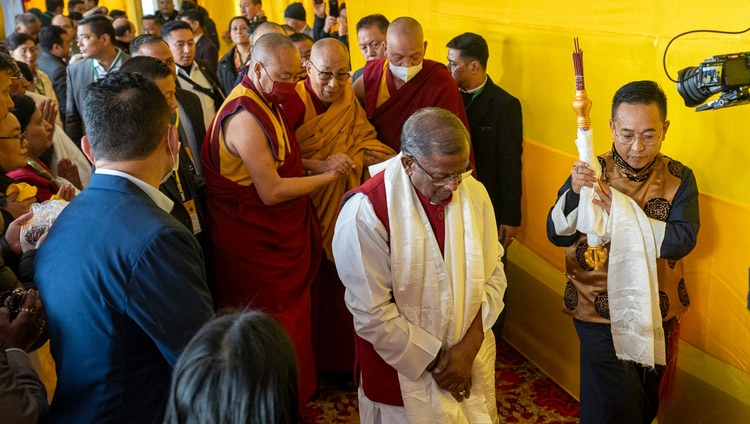Gangtok, Sikkim, India, 12 December 2023: When His Holiness the Dalai Lama arrived at the Paljor Stadium this morning, he was received at the door by Shri Sonam Lama, Hon’ble Minister of the Ecclesiastical Affairs Department. When he reached the pavilion from which he would teach, he was welcomed once again by H.E. Lakshman Prasad Acharya, Governor of Sikkim and Shri Prem Singh Tamang (Golay), Hon’ble Chief Minister of Sikkim.
Tsechokling Rinpoché spoke a few words of welcome to the dignitaries seated on the stage and to the estimated 40,000 people assembled in stadium, some of whom had arrived before 4:00 am. He invited the Chief Minister to speak.
“Namo Buddhaya,” he began and proceeded to welcome His Holiness, Rinpochés, the Hon. Governor of Sikkim, the Hon. Chief Justice of the Sikkim High Court, the Speaker and Deputy Speaker of the Sikkim Legislative Assembly, Ministers and other esteemed dignitaries. Addressing representatives of the media and members of the public, he said:
“I welcome each and every one of you on this auspicious occasion.
“I welcome His Holiness the Dalai Lama, the manifestation of Avalokiteshvara to the beautiful, green state of Sikkim.
“Today, we are in the presence of one of the world’s most respected spiritual leaders. His message regarding the oneness of humanity inspires people around the world. He has come all the way from Dharamsala to speak to us, for which I express a great debt of gratitude. Our spirits will be lifted by his words; our intentions will become pure. Listening to his explanation of Gyalsey Thogmé Sangpo’s ‘Thirty-seven Practices of Bodhisattvas’ will help us find the path of peace as we negotiate our way through modern life. I am honoured once again, on behalf of the people of Sikkim, to express our gratitude.”
His Holiness offered the Chief Minister a statue of the Buddha.
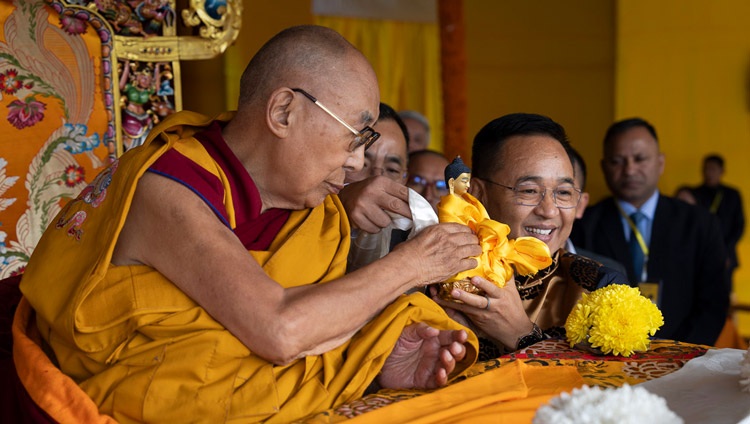
His Holiness the Dalai Lama offering a statue of the Buddha to Sikkim Chief Minister Shri Prem Singh Tamang at the start of teachings at Paljor Stadium in Gangtok, Sikkim, India on December 12, 2023. Photo by Tenzin Choejor
“Today, the disciples are mainly people from Sikkim and its neighbours,” His Holiness began, speaking in Tibetan that was translated into Nepalese and other languages. “Many people have come here out of regard for me; I welcome you all.
“Most of you have a religious practice and many of you have an interest in the teaching of the Buddha. We human beings, from the moment we’re born, do not want to suffer; we want to be happy. This is a natural instinct that we share even with birds and animals. All living beings simply want to be happy, and human beings are able to articulate this wish. Nevertheless, we persist in engaging in activities that bring us sorrow.
“We see other people as somehow different from us; as people who have different beliefs from us. However, I respect all religious traditions, and wherever I go, I visit other people’s places of worship, churches, mosques and temples, and pay my respects there.
“People create divisions on the basis of religious faith when what we need is harmony and friendship. Here in India, the Land of the Noble Ones, we find all our religious traditions, Islam, Judaism, Christianity, Hinduism and so forth and they co-exist in harmony. They may adopt different philosophical points of view, but they share a common message about the need to cultivate a good heart, a warm heart. And it is for this reason that all these religious traditions deserve our respect.
“Religion should be able to help us resolve our problems, but instead we too often create problems in the name of religion. Within Buddhist tradition we have four schools of philosophical tenets: Particularists (Vaibhashika), Sutra Followers (Sautrantika), Mind Only (Chittamatra) and the Middle Way (Madhyamika), but they all share a common emphasis on cultivating warm-heartedness.
“We should not let religion divide us. As I’ve already mentioned, I respect all religious tradition because they all advise us to be honest and warm-hearted. Some faiths believe in a creator god, others do not. But, as I usually say, religious faith is a personal matter. However, it remains the case that all human beings need a good heart, which is why I consider secular ethics to be so important.
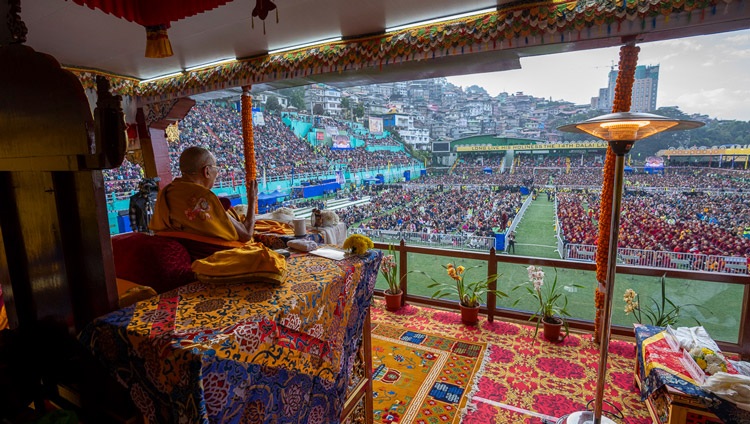
His Holiness the Dalai Lama addressing the gathering of over 40,000 at Paljor Stadium in Gangtok, Sikkim, India on December 12, 2023. Photo by Tenzin Choejor
“Essentially, all human beings want to be happy, but when we look back at history, we see how often wars have been fought in the name of religion. This approach is out of date. It’s the responsibility of each and every one of us to work to create a peaceful, harmonious world.”
His Holiness declared that we have enough trouble dealing with natural disasters and so forth, without adding to it by squabbling in the name of religion. When we were born we had no religion. Having given birth to us, our mother cared for us with love and affection. Without that we would not have survived. This is true of all human beings and is a good reason why we should help each other. His Holiness reiterated that we need to help one another with a keen sense of the oneness of humanity. If we can do that, he said, we’ll be able to build a happier world.
His Holiness drew attention to the tremendous resources employed to make ever more powerful weapons whose use is only destructive. He repeated that wherever he goes, he points out that we are all the same, we all want to be happy, therefore we need to be friendly to each other.
“Many people died in the recent floods here in Sikkim. We should pray for everyone who was affected, those who died and those still living. We’ll say one round of a ‘mala’ of ‘manis’ together. People in Tibet and the neighbouring Himalayan region have a close connection to Avalokiteshvara. We have a custom of saying Om mani padme hung, so today we’ll recite a round together for those who suffered as a result of the recent disaster. We can dedicate whatever merit we create to achieving the state of Avalokiteshvara.
“The Thirty-seven Practices begins by paying homage to Avalokiteshvara who is praised by all the Buddhas and has accomplished all qualities and who ‘while seeing that all phenomena lack coming and going, makes a single-minded effort for the good of all living beings’.
“Whatever exists does not do so from its own side. Things exist by way of designation. People and things are dependently arisen and it’s because of that that it’s important that we live in harmony with each other.
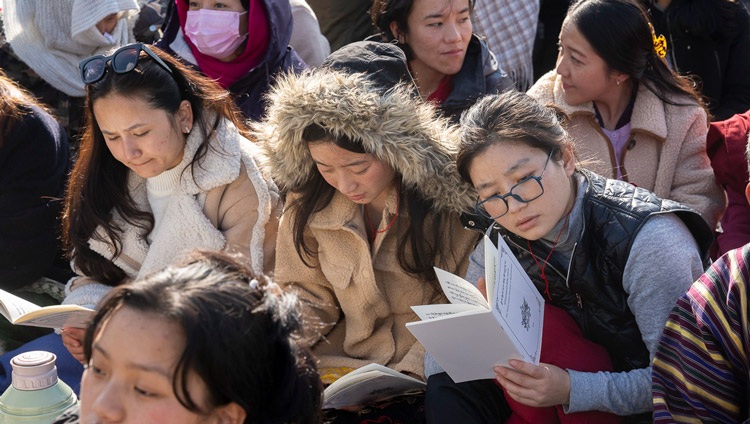
Members of the crowd following His Holiness the Dalai Lama’s teachings on Gyalsey Thogmé Sangpo’s “37 Practices of a Bodhisattva” during the teaching at Paljor Stadium in Gangtok, Sikkim, India on December 12, 2023. Photo by Tenzin Choejor
“The text tells us to listen to explanations of how people and things lack inherent existence, to reflect on what we’ve learned and meditate on what we’ve understood. I make the awakening mind of bodhichitta and the wisdom understanding emptiness the core of my practice. Consequently, when I think of the trouble people in Tibet have been put to because of communist ideology, I’m not angry or moved by hatred. I feel compassion for those who have made things difficult for us.
“If you can, when you wake in the morning, generate bodhichitta. Then your negative thoughts will subside, and you’ll find peace of mind. Bodhichitta brings happiness and well-being to others and to us. I find that training my mind to cultivate bodhichitta not only brings peace of mind, but enhances my sense of physical well-being.
“Bodhichitta makes you relaxed and able to sleep soundly; it sets your mind at ease. You’ll no longer be jealous or competitive.
“I grew up basking in my mother’s loving kindness and later learned formally about cultivating bodhichitta. Now, I’m 88 years old, almost 90, and I have a calm, relaxed mind. Of course, accumulating merit and wisdom ultimately takes us to enlightenment, but in my experience, we can also feel the effect they have on our day-to-day lives. There are several explanations about how to generate bodhichitta, but even if you can’t think deeply about them, if you can cultivate a warm-hearted attitude towards others, it will bring you peace of mind.”
His Holiness took up the ‘Thirty-seven Practices’ and read through the verses highlighting the advice to give up your homeland; cultivate seclusion; let go of this life; give up bad friends; cherish the spiritual teacher; take refuge in
The Three Jewels; never do wrong; aspire to the never-changing supreme state of liberation and develop the altruistic intention—these are the practices of Bodhisattvas.
The text goes on: exchange your own happiness for the suffering of others; dedicate your body, possessions and your virtue, past, present and future to those who steal from you; take all the other’s misdeeds upon yourself. When someone disparages you, place them, as you would your spiritual teacher, on the crown of your head; take on the misdeeds and the pain of all living beings; see all worldly fortune as without essence; subdue your own mind; abandon clinging attachment, and do not take to mind (inherent) signs of subject and object—this, His Holiness remarked, refers to emptiness.
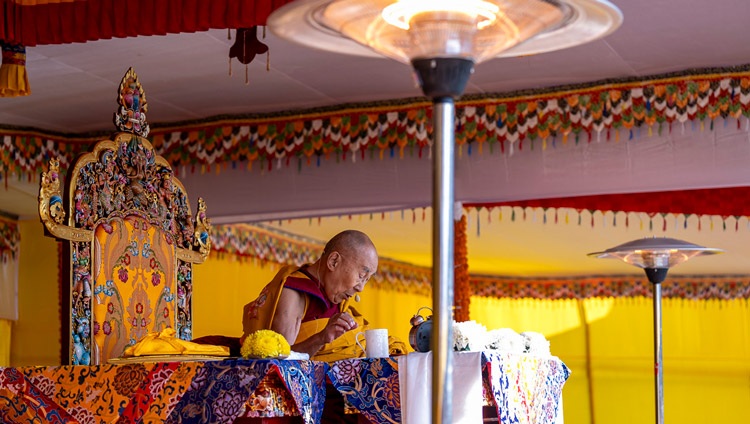
His Holiness the Dalai Lama reading from Gyalsey Thogmé Sangpo’s “37 Practices of a Bodhisattva” during his teaching at Paljor Stadium in Gangtok, Sikkim, India on December 12, 2023. Photo by Tenzin Choejor
Don’t regard things as real and give up attachment; see them as illusory, and safeguard your ethical discipline. Along with skillful means cultivate the wisdom which does not conceive the three spheres (as real). His Holiness mentioned that with regard to emptiness, it’s important to study the Middle Way (Madhyamika) treatises such as Nagarjuna’s ‘Fundamental Wisdom of the Middle Way’, Aryadeva’s ‘400 verses’ and most especially Chandrakirti’s ‘Entering into the Middle Way’.
The text continues: examining your own errors, rid yourself of them; don’t mention the faults of those who have entered the Great Vehicle; give up attachment to the households of friends, relations and benefactors; give up harsh words; destroy disturbing emotions like attachment as soon as they arise; whatever you are doing,
ask yourself ‘What’s the state of my mind?’ and finally, dedicate the virtue from making such effort to enlightenment—this is the practice of Bodhisattvas.
Having completed his reading of the teaching on the Thirty-seven Practices His Holiness reminded his listeners that the essence is to have a good heart and to be determined not to part from the wish to benefit sentient beings. To have an altruistic mind is what’s most important.
With regard to wisdom His Holiness recommended reading and reflecting on a series of verses from chapter six of Chandrakirti’s ‘Entering into the Middle Way’. He stated that he recites and reflects on these verses every day and he recognises what a deeply positive effect this has had on his mind. Things may appear to exist inherently, but in fact they only exist by way of designation.
If the intrinsic characteristics of things were to arise dependently,
things would come to be destroyed by denying it;
emptiness would then be a cause for the destruction of things.
But this is illogical, so no real entities exist. 6.34
Thus, when such phenomena are analyzed,
nothing is found as their nature apart from suchness.
So the conventional truth of the everyday world
should not be subjected to thorough analysis. 6.35
In the context of suchness, certain reasoning disallows arising
from self or from something other, and that same reasoning
disallows them on the conventional level too.
So by what means then is your arising established? 6.36
Empty things dependent on convergences,
such as reflections and so on, are not unknown.
And just as from an empty thing like a reflection
a perception can arise that bears its form, 6.37
likewise although all things are empty,
they do arise from emptiness in a robust way.
Since no intrinsic nature exists in either of the two truths,
phenomena are neither eternal nor annihilated. 6.38
“With that,” he said, “were done.”
There followed a short ceremony on behalf of the people of Sikkim. On the basis of a few short verses they made fervent prayers for His Holiness’s long and healthy life. They requested him to live for aeons for the benefit of all sentient beings. Visualizing the entire world as a Buddha-field, they offered it to him.

Dignitaries parading by with offerings for His Holiness the Dalai Lama during the Long Life Prayer at Paljor Stadium in Gangtok, Sikkim, India on December 12, 2023. Photo by Tenzin Choejor
“May you live until cyclic existence comes to an end. May the sound of the Dharma drum dispel all suffering. May you live long to liberate beings from misery.
“You who clarify the teaching combining emptiness and compassion, Lord and Protector of the Land of Snow, Avalokiteshvara in person, may all your aspirations be fulfilled.”
A series of cultural presentations was performed to celebrate today’s happy occasion. First a team from the Sikkim Cultural Department sang and danced. They were followed by a group of women and men from the Tibetan community, apparently representing the three provinces of Tibet, as indicated by their costumes. They sang and danced with exuberant joy while His Holiness looked on and smiled in appreciation.
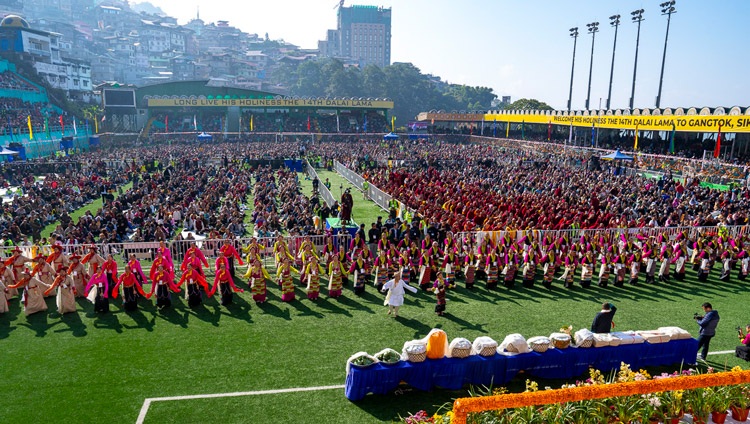
Members of the Tibetan community of Sikkim performing in traditional regional dress during the Long Life Prayer offering for His Holiness the Dalai Lama at Paljor Stadium in Gangtok, Sikkim, India on December 12, 2023. Photo by Tenzin Choejor
As proceedings came to an end, Tsewang Doma, Additional Secretary of the Home Department requested His Holiness to inaugurate two projects virtually from where he sat. First, he was invited to lay the foundation stone of the Karmapa Park Project at Rumtek, a project organized by the Tourism Department. Next, he was requested to lay the foundation stone of the Gyalwa Lhatsun Chenpo Statue to be erected in the Simick-Khamdong Constituency, East Sikkim at the behest of the Culture Department.
Shri Sonam Lama, Hon’ble Minister of the Ecclesiastical Affairs Department of the Government of Sikkim offered words of thanks. He began by observing that Sikkim is a hidden land blessed by Guru Padmasambhava. He thanked His Holiness for the teaching and significant advice he had given the people of Sikkim today. He thanked the dignitaries who had attended today’s celebrated event and expressed gratitude to Tsechokling Rinpoché and his team for their good organisation.
“The Chief Minister and I went personally to Dharamsala to invite His Holiness to our state,” he recalled. “Since the time of Gyalwa Lhatsunpa, the first Chögyal, and the Great Fifth Dalai Lama there have been strong connections between the Dalai Lamas and Sikkim. For us His Holiness represents both Guru Padmasambhava and Avalokiteshvara and it has been our great good fortune to invite him here. Once again I’d like to thank everyone who has contributed to this great event.”
The day’s program was completed with the recitation of auspicious verses.

